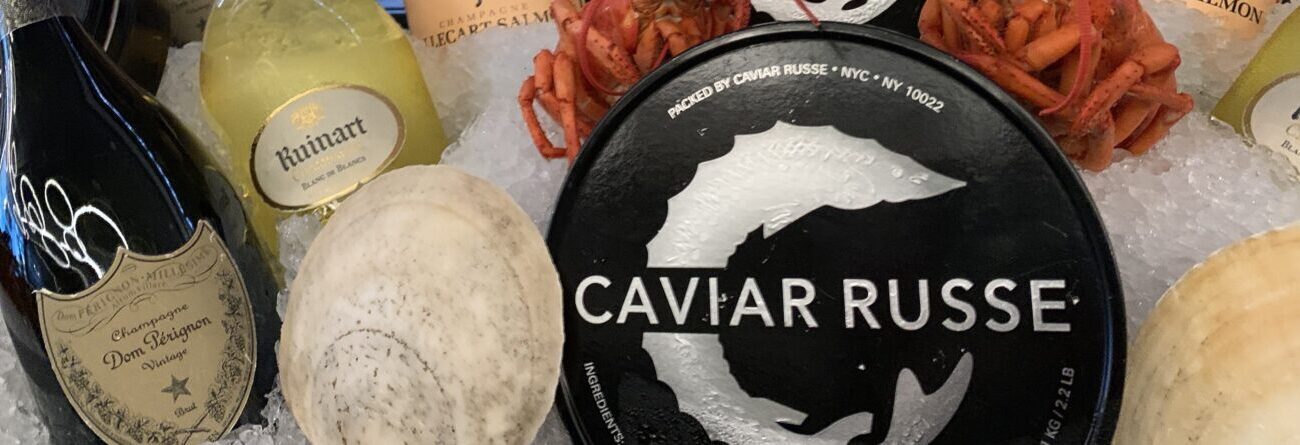
Your Quick Guide to Caviar Tasting
Though never quite out of vogue, caviar returned to the spotlight in 2022. It found a new following this summer as Gen Z and Millennials took caviar bumps (eating dollops off their hands) at bars and lounges in major cities. Caviar’s ubiquity has stemmed from an industrialization of the product – China now produces about 95% of the world’s caviar en-masse via commercial farms. But for authentic caviar, look no further than Caviar Russe, the high-end caviar-tasting experience operating in New York and Miami. For more than 20 years, Caviar Russe has held an exclusive arrangement with a Frankfurt-based, small-batch, sustainable sturgeon farm. The Related Life sat with Edward Panchernikov, co-founder at Caviar Russe, to learn more about the different types of caviar and what makes for an exceptional tasting experience.
“We like to preserve the tradition of Caspian Sea caviar, so we want our caviar to look, feel and taste like caviar that was originally from there,” Edward said. We are not buying from somebody else and putting our sticker on it – we sourced it. At each harvest, we are there to check the quality. We think we’ve gotten really close to the original profile of caviar.”
Keep reading for interview excerpts that will tell you everything you need to know about caviar!
So, what is caviar?
Caviar is fish eggs, or roe, that come from sturgeon. All fish have roe but only sturgeon eggs are caviar. For example, salmon or paddlefish eggs are roe, not caviar.
Originally, caviar came from the Caspian Sea, which is bordered by Russia, Iran, Kazakhstan, Uzbekistan. Also from the Black Sea, dating back ages to the Ancient Greeks.
In the 1990s with the collapse of the Soviet Union, there was a ton of sturgeon overfishing. Why? It was the first time that caviar could really get out of the Soviet Union; there was no more embargo.
By the 2000s, the industry had switched to sustainable farming. And today, there is no wild caviar that is legal in the U.S. What you are enjoying in the U.S. and throughout the world is farmed caviar. Although there is still some evidence of poaching in Russia and Iran.
What are the different types of caviar?
There are five main types of sturgeon farmed for caviar. They are:
Osetra: Caspian Osetra offers a medium- to large-grain caviar that may be light to dark brown in color, sometimes with golden highlights. The Osetra Caviar eggs tend to be firmer in contrast to most of the other sturgeon species and present a deep and complex full-flavored tasting experience.
Sevruga: Sevruga caviar is of a small grain that is sometimes light in color, but most often dark grey. It is very flavorful, offering an abundantly rich profile with excellence balance and finish. The eggs of the Sevruga are a wonderful treat.
Sterlet: Female Sterlet mature after five to seven years and produce a small-grain caviar. Sterlet caviar is light to dark gray in color and has a distinctively strong and intense flavor. Caviar from the lesser known Sterlet Sturgeon is most similar to Sevruga with regard to size and overall appearance, offering an assertive-styled caviar with a clean finish.
Siberian Sturgeon: Female Siberian Sturgeon mature after 5 or 6 years and provide a small- to medium-grain caviar that is predominantly dark brown to black in color, offering great concentrated caviar flavor. Originating from pure Siberian sturgeon stocks of the Lena, this Baeri caviar is deep mahogany to black in color, small to medium in grain, and expresses a clean and focused flavor brimming with taste.
Pacific Sturgeon: Also known as White Sturgeon, this is fish is of Pacific Northwest lineage. The medium- to large-sized fragile grey to charcoal-toned caviar offers a mild flavor and clean finish.
Editor’s Note: Beluga sturgeon is moving toward being overhunted, so it is not included in our list.
What is the flavor profile of caviar? How do you know the caviar you are eating is fresh?
Each caviar has its own distinct flavor, based upon the species of surgeon. These flavors have to do with the nature of the fish and how it grows. Some fish take five years to produce caviar, while others mature in 10, 15 or 20 years. Thus the expense of caviar is tied to its scarcity. It’s also tied to the act of farming – consider that these farms have to protect, feed and care for the fish until they are able to produce caviar. There are costs with food and electricity.
Good caviar is not really fishy. It is buttery. If you are tasting it and have a musky flavor in your mouth, that is old caviar. That’s where you see places serving with a lot of the garnishes – like onions or egg yolk, or masking with different toppings. At Caviar Russe, we keep it simple with crème fraiche and chives.
There are two types of caviar I’d like to highlight. Sevruga caviar is not the prettiest, but it has the original caviar flavor. It is considered the blue cheese of caviar. I find the flavor amazing.
Then there is the Osetra. It’s special because it has all these different gradings. When they start butchering the fish, you have no idea what color the caviar will come in. The color is random with breeding. The way Osetra is priced and graded is by scarcity. Amas Osetra, for example, is top-priced. It will have golden or bright yellow eggs and will be creamy and mild. When there is scarcity of pigmentation, it softens the shell of the egg. You get more than of that buttery, rich, umami flavor.
The Related Life is written and produced by the Related Life Editorial Team. Be sure to follow us on Facebook and Instagram for the latest events, news and announcements in your area, and tag us for a chance to be featured @therelatedlife and #therelatedlife.